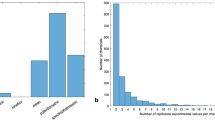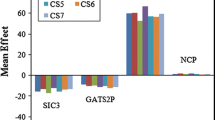Abstract
A novel approach is introduced for reliable prediction of the retention time of morphine and its derivatives, which have widespread use in medical and pharmaceutical applications. A core correlation is introduced based on the number of carbon and hydrogen atoms as well as the number of ester, noncyclic ether, and ketone functional groups from experimental data of 42 compounds. An improved correlation is developed to increase the reliability of the core correlation by inserting a correcting function. The reliability of two correlations is tested and compared with the best available complex method based on a backpropagation artificial neural network (BP-ANN) for further 15 compounds. The values of root mean squared error (RMSE) of core and improved correlations for the test set are 0.5681 and 0.4832 min, which are lower than those reported by BP-ANN (0.6052 min). Cross-validations of the improved correlation corresponding to the coefficients of determination for leave-one-out (Q2LOO) and the fivefold cross-validation (Q25CV) are close to its the coefficient of determination (R2 = 0.982), which confirms goodness-of-fit, goodness-of-prediction, accuracy, and precision of the novel model.



Similar content being viewed by others
References
Serafini RA, Zachariou V (2019) J Clin Investig 129:1–3
Brook K, Bennett J, Desai SP (2017) J Anesth History 3:50–55
Lightbourn A, Zhu Z-P, Goodman CB (2020) Glob J Med Res 20:1–25
Zapadka M, Kaczmarek M, Kupcewicz B, Dekowski P, Walkowiak A, Kokotkiewicz A, Łuczkiewicz M, Buciński A (2019) J Pharm Biomed Anal 164:681–689
Agrawal JP (2010) High energy materials: propellants, explosives and pyrotechnics. Wiley, Weinheim
keshavarz MH (2018) Liquid fuels as jet fuels and propellants: a review of their productions and applications. Nova Science Publishers, Inc., New York
Keshavarz MH (2018) Combustible organic materials: determination and prediction of combustion properties. Walter de Gruyter GmbH & Co KG, Berlin
Keshavarz MH, Klapötke TM (2017a) Energetic compounds: methods for prediction of their performance. Walter de Gruyter GmbH & Co KG, Berlin
Keshavarz MH, Klapötke TM (2017b) The properties of energetic materials: sensitivity physical and thermodynamic properties. Walter de Gruyter GmbH & Co KG, Berlin
Klapötke TM (2018) Energetic materials encyclopedia. Walter de Gruyter GmbH & Co KG, Berlin
Klapötke TM (2019) Chemistry of high-energy materials. Walter de Gruyter GmbH & Co KG, Berlin
Mozafari Z, Chamjangali MA, Arashi M (2020) Chemometrics and Intelligent Laboratory Systems:103998.
Hadni H, Elhallaoui M (2020) Heliyon 6:e03580
Manouchehrizadeh E, Mostoufi A, Tahanpesar E (2019) Fereidoonnezhad MJCb, chemistry. Comput Biol Chem 80:463–471
Bahmani A, Tanzadehpanah H, Hosseinpour Moghadam N, Saidijam M (2020) Mol Divers:1–17.
Jiang J, Duan W, Wei Q, Zhao X, Ni L, Pan Y, Shu C-M (2020) J Mol Liq:112471.
Keshavarz MH, Pouretedal HR, Saberi E (2017) Zeitschrift für anorganische und allgemeine Chemie 643:171–179
Keshavarz MH, Pouretedal HR, Saberi E (2018) Process Saf Environ Prot 116:333–339
Keshavarz MH, Pouretedal HR, Saberi E (2016) J Mol Liq 216:732–737
Rahimi R, Keshavarz MH, Akbarzadeh AR (2016) Cent Eur J Energ Mater 13:73–101
Keshavarz M, Akbarzadeh A (2019) SAR QSAR Environ Res 30:347–361
Jafari M, Keshavarz MH, Salek H (2019) Ecotoxicol Environ Saf 182:109429
Turaci MÖ (2020) J Mol Struct 1207:127766
Amos RI, Haddad PR, Szucs R, Dolan JW, Pohl CA (2018) TrAC, Trends Anal Chem 105:352–359
Bahmani A, Saaidpour S, Rostami A (2017) Chromatographia 80:629–636
Ronco NR, Menestrina F, Romero LM, Castells CB (2019) J Chromatogr A 1584:179–186
Passos H, Dinis TB, Capela EV, Quental MV, Gomes J, Resende J, Madeira PP, Freire MG, Coutinho JA (2018) Phys Chem Chem Phys 20:8411–8422
Lenca N, Atapattu SN, Poole CF (2017) J Chromatogr A 1526:13–22
Hosaka T, Imai T, Wzorek A, Marcinkowska M, Kolbus A, Kitagawa O, Soloshonok VA, Klika KD (2019) Amino Acids 51:283–294
Riahi-Zanjani B, Balali-Mood M, Es’haghi Z, Asoodeh A, Ghorani-Azam A (2019) J Mol Model 25:54
Rong Y, Meng Z, Li J, Zhu X, Gan H, Gu R, Wu Z, Sun W, Liu T, Zheng Y (2018) J Pharm Biomed Anal 154:444–453
Zhang X-x (2017) Yu H, Wang G. J Liq Chromatogr Relat Technol 40:671–676
Verpoorte R, Svendsen AB (1984) Chromatography of alkaloids. Part B. gas-liquid chromatography and high-performance liquid chromatography (J Chromatogr Library). Elsevier, Amsterdam, pp 132–133
Golbraikh A, Tropsha A (2002) J Mol Graph Model 20:269–276
Papa E, Kovarich S, Gramatica P (2009) QSAR Comb Sci 28:790–796
Roy K, Mitra I (2011) Comb Chem High Throughput Screen 14:450–474
Rücker C, Rücker G, Meringer M (2007) J Chem Inf Model 47:2345–2357
Gramatica P, Chirico N, Papa E, Cassani S, Kovarich S (2013) J Comput Chem 34:2121–2132
Gramatica P, Pilutti P, Papa E (2007) SAR QSAR Environ Res 18:169–178
Mitra I, Saha A, Roy K (2010) Mol Simul 36:1067–1079
Roy K, Kar S, Das RN (2015) A primer on QSAR/QSPR Modeling: fundamental concepts. Springer, Berlin
Gramatica P (2013) On the development and validation of QSAR Models. Computational toxicology. Springer, Berlin, pp 499–526
Gramatica P (2020) Int J Quant Struct-Prop Relat (IJQSPR) 5:1–37
Gramatica P, Cassani S, Chirico N (2014) J Comput Chem 35:1036–1044. https://www.qsar.it.
Keshavarz MH, Motamedoshariati H, Moghayadnia R, Ghanbarzadeh M, Azarniamehraban J (2013) Propellants Explos Pyrotech 38:95–102
Keshavarz MH, Soury H, Motamedoshariati H, Dashtizadeh A (2015) Struct Chem 26:455–466
Keshavarz MH (2010) J Hazard Mater 177:648–659
Keshavarz MH, Bashavard B, Goshadro A, Dehghan Z, Jafari M (2015) J Therm Anal Calorim 120:1941–1951
Keshavarz MH (2008) J Hazard Mater 151:499–506
Keshavarz MH, Ghani K, Asgari A (2015) J Therm Anal Calorim 121:675–681
Palm WJ III (2011) Introduction to MATLAB for engineers. McGraw-Hill, New York
Kamalvand M, Keshavarz MH, Jafari M (2015) Propellants Explos Pyrotech 40:551–557
Leach AR, Gillet VJ (2007) An introduction to chemoinformatics. Springer, The Netherlands
Tropsha A (2010) Mol Inform 29:476–488
Kutner MH, Nachtsheim C, Neter J (2004) Applied linear regression models. McGraw-Hill/Irwin, New York
Puzyn T, Leszczynski J, Cronin MT (2010) Recent advances in QSAR studies: methods and applications. Springer Science & Business Media, Berlin
Meloun M, Militký J, Hill M, Brereton RG (2002) Analyst 127:433–450
Meloun M, Bordovská S, Kupka K (2010) J Math Chem 47:891–909
Acknowledgement
We would like to thank the Malek-ashtar University of Technology for supporting this work. We want also to thank Professor Dr. Paola Gramatica for providing QSARINS version 2.2.4.
Funding
This study was self-funded, no fund is received.
Author information
Authors and Affiliations
Corresponding author
Ethics declarations
Conflict of Interest
No conflict of interest of any kind.
Research Involving Human or Animal Participants
This article does not contain any studies with human participants or animals performed by any of the authors.
Additional information
Publisher's Note
Springer Nature remains neutral with regard to jurisdictional claims in published maps and institutional affiliations.
Electronic supplementary material
Below is the link to the electronic supplementary material.
Rights and permissions
About this article
Cite this article
Keshavarz, M.H., Shirazi, Z. & Rezayat, M.A. Prediction of Retention Time of Morphine and Its Derivatives Without Using Computer-Encoded Complex Descriptors. Chromatographia 84, 87–96 (2021). https://doi.org/10.1007/s10337-020-03975-z
Received:
Revised:
Accepted:
Published:
Issue Date:
DOI: https://doi.org/10.1007/s10337-020-03975-z




